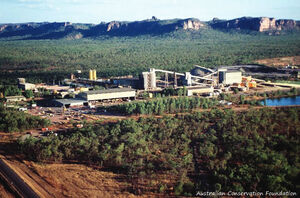
Queensland uranium mining
Thursday September 12 2013
Yellowcake fever?
The Newman Government has today taken the next step in re-establishing the uranium mining industry in Queensland.
Natural Resources and Mines Minister Andrew Cripps today released an action plan to implement a best practice regulatory framework for uranium mining in Queensland that will ensure the maintenance of strict environmental, safety and approval standards.
“The government has developed this implementation strategy in response to a detailed report by the Uranium Mining Implementation Committee (UMIC) which was released in March 2013,” Mr Cripps said.
“The strategy outlines the actions various state government agencies will deliver and covers all aspects of the approvals process, including environmental standards, safety and health, economic and community development, indigenous opportunities and native title.”
Mr Cripps said uranium exports had the potential to generate significant revenue for Queensland over the next two decades.
“With an estimated value of the in-ground uranium resource in Queensland of approximately $10 billion, with more than $8 billion located in north-west Queensland, the industry has real potential to support economic growth and job creation,” he said.
However, the Australian Conservation Foundation said today the new ‘action plan’ to advance uranium mining is in direct conflict with clear commitments made by the new Coalition Federal Government during the recent election campaign,
A feature of the Queensland Government’s yellowcake roadmap is a push to have “all uranium mining proposals in Queensland” assessed and approved by the state government.
According to the ACF, such a move conflicts with a recent federal Coalition commitment to ACF that under the “proposed streamlining of approval processes under the EPBC, our intention is for uranium mining to be one area where the Federal Government would retain control and would not implement a bilateral approval process”.
“Uranium mining is an issue of national interest and importance and is rightly a matter for the active consideration of the national government,” said ACF’s Dave Sweeney.
“We welcome the Federal Coalition’s re-affirmation of this and urge the Queensland Government to stop trying to cut corners for this contested and contaminating industry.”
The Queensland plan has been released on the same day as market analysis by economic forecaster Morgan Stanley which shows the uranium price has slumped by nearly 50 per cent since the 2011 Fukushima nuclear crisis, a continuing emergency that was directly fuelled by Australian uranium. Uranium accounted for only 0.29 per cent of Australian export revenue and less than 0.015 per cent of national jobs in the decade to 2011.
“The Queensland environment and community deserves better than the inadequate and ill-considered plan released today,” Mr Sweeney said.
ACF’s report, ![]() Yellowcake Fever: exposing the uranium industry’s economic myths, uses official industry data to show that the uranium sector is a minor contributor to employment and the economy, a major source of domestic and international risks and is overdue for an independent inquiry into its effects on the environment, health, safety and security.
Yellowcake Fever: exposing the uranium industry’s economic myths, uses official industry data to show that the uranium sector is a minor contributor to employment and the economy, a major source of domestic and international risks and is overdue for an independent inquiry into its effects on the environment, health, safety and security.
“The government’s focus is to ensure all the uranium-specific regulatory guidelines and protocols are in place to begin assessing applications from mid-July 2014," Mr Cripps said.
“Importantly, the Newman Government has endorsed the Committee’s key finding that, with certain adaptations, Queensland’s existing systems for regulating mining and radiation safety are robust and can accommodate uranium across the mining cycle.”
The best practice regulatory framework will take account of all relevant issues across the uranium mining life cycle such as:
- Whole of project assessments (including tenure management)
- Safe handling and transportation
- Safety and health risk management systems
- Environmental management, and
- Native title
A Uranium Mining Oversight Committee will be established to review and monitor progress against the action plan and take a lead role on technical oversight issues, project governance and delivery timeframes.
Mr Cripps said commercial demand for uranium would determine when uranium mining would recommence in Queensland.
“There are a number of factors that will influence the timing of uranium mining operations and it is ultimately a commercial decision for industry proponents," he said.
“These factors include the world market price for uranium, supply and demand in that market, and mining costs.
“The Queensland Government’s role is to provide investment certainty for industry by having best practice regulatory, compliance and approval processes in place.”
More information is available at:
http://mines.industry.qld.gov.au/mining/uranium.htm
